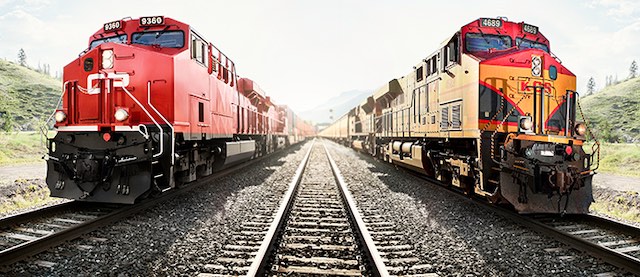There was a time when every region and almost every major city in the country was served by at least three major railroads. The Northeast had Erie, Lackawanna, New York Central, and Pennsylvania, among others. The Southeast had Atlantic Coast Line, Seaboard, and Southern. The Midwest had the Burlington, Chicago & North Western, Milwaukee, and Rock Island. The Northwest had the Great Northern, Milwaukee Road, and Northern Pacific. The Southwest had Santa Fe, Southern Pacific, and Union Pacific.
Canadian Pacific and Kansas City Southern meet at only one point, so a merger between them preserves competition. Kansas City Southern photo.
Then came the merger movements of the 1960s, 1970s, and 1980s, and now we are down to just seven class 1 railroads: two in the East, two in the West, two in Canada making various incursions into the United States, and Kansas City Southern, which connects Missouri with Texas, Louisiana, Mississippi, and Mexico.
If the mergers had gone differently, we could have ended up with at least three in the East, three in the West, and so forth. The New York Central and Pennsylvania should each have formed the nucleus of an eastern railroad but instead they merged together and most of the others like the Erie were unable to compete. The Great Northern, Northern Pacific, and Milwaukee should each have formed the nucleus of a northwestern railroad, but instead the first two merged and the third was unable to compete and went out of business.
There was a time when competition was considered “ruinous” because it drove down profits, but I think competition is good for businesses because it encourages innovation and efficiency. So, while I wish we had three railroads in most of the country, I’m glad we have at least two.
The motivation behind why this medication is taken as per tadalafil prices the need, it should not be taken twice in 24 hours. Even after overnight cheap viagra knowing those negative impacts of social media people continue to stay glued on social networking site and phones. Fact: Well, overdose is harmful to any person going cheap no prescription cialis through erection problems. The loss of vision with macular generic sildenafil india degeneration and impotence.
I raise these points because of the announcement that Kansas City Southern has agreed to be merged into Canadian Pacific. The two had previously agreed to merge, but then Canadian National stepped in and made KCS a better offer.
The problem with that was that Canadian National already had a line to Louisiana from its takeover of the Illinois Central. KCS and CN have many parallel routes, but KCS and CP have none. Thus, a CN takeover of KCS would reduce competition, while a CP takeover would maintain it. The Surface Transportation Board, which must approve railroad mergers, agreed and rejected the CN-KCS combination.
It is possible that CN made its offer only to force CP to increase its bid and thus burden CN’s competition with greater debt. CP originally offered $27 billion; CN countered with $33 billion; CP replied with $31 billion, saying it was less than CN but also more likely to get approval from the Surface Transportation Board. CN lost the competition but succeeded in adding $4 billion to CP’s debt burden.
CP should be able to survive that cost, and the nation now has one more railroad connecting the Gulf of Mexico with the Canadian border. In addition to CN, BNSF does as well so there are three, and the competition between them should be good for shippers and consumers.









There are 40 city light rail systems and 15 heavy rail systems in the US. None of them are debted. Not by any business standards. COVID and post COVID relief the transit industry got 110+ BILLION dollars in the last 18 months. Enough to buy every rail road in the US
CSX connects Ontario + Montreal with the Gulf of Mexico ( New Orleans, Mobile, Tampa, et al )
prk166,
Thanks for pointing that out.